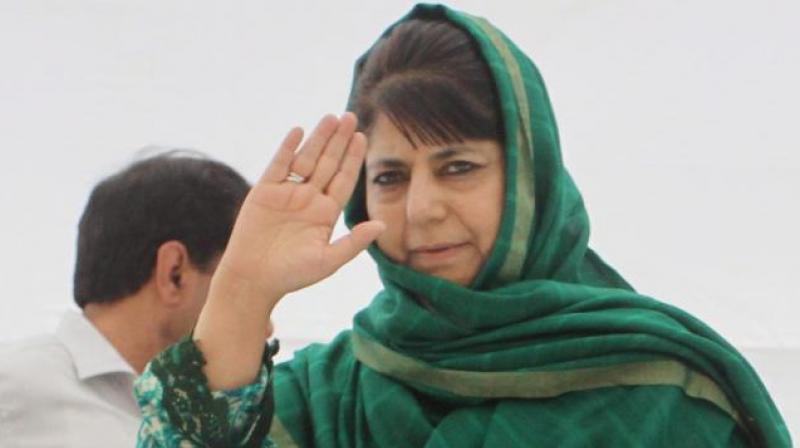RSS always wanted the division of Kashmir

Mehbooba Mufti had only to ask for a mere “divisional status” for the Chenab Valley and the Pir Panjal areas for Karan Singh to scream that she was trying to break up Jammu. This from a man who has always been for a breakup of Jammu & Kashmir; particularly since the mid 1960s. He sponsored all manner of moves for a breakup while keeping his links with the Congress government at the Centre in good repair.
In himself, Karan Singh is a very small man; indeed, it is his lurking capacity to fuel the flames of hate in Jammu that matters, given the state of politics today. As the son of the last ruler of the princely state, Hari Singh, he inherited the Dogra resentment of Sheikh Abdullah’s rise to becoming premier of J&K.
The Rashtriya Swayamsevak Sangh (RSS) has ever been an advocate of trifurcation into the Muslim Valley, the “Hindu” Jammu and the Buddhist Ladakh. In 1947, the Muslims were in a majority in Jammu. The massacre of Muslims organised by Hari Singh reduced their majority (61 per cent) to a minority (30 per cent) by 1961. It is not a regional, but a highly communal resurgence, that we now witness.
The scholar Christopher Jaffrelot records that, in 1981, Karan Singh founded the Virat Hindu Samaj. Karan Singh became its president; its officers were RSS and Bharatiya Janata Party (BJP) stalwarts — Hans Raj Gupta and O.P. Tyagi (vice presidents), V.H. Dalmia (treasurer) and Ashok Singhal (general secretary).
To Braj Kumar Nehru, governor of J&K, he candidly expounded his ideas. Shortly before he was sworn in as governor on February 26, 1981, B.K. Nehru met him and was told that those five different entities of J&K had nothing in common with each other. The hill areas of Gilgit, Baltistan and Skardu and the Punjabi-speaking areas of Muzaffarabad, etc were already in the hands of Pakistan. “In our part of (Kashmir), there were three clear divisions — Jammu, which was Hindu, Kashmir, which was Sunni Muslim and Ladakh, one part of which was Buddhist and the other (Kargil) Shia Muslim. Because of the lack of commonality between these three divisions, the sooner they were separated the better it would be for the future.” The RSS has consistently supported such a trifurcation.
However, on Oct 2, 2000, Farooq Abdullah warned that, in such an event, the districts of Doda, Poonch and Rajouri would not live with Jammu and that it would trigger something worse than the Jammu massacres in 1947. Jammu would split evenly. Gool Gulab Garh tehsil in Udhampur, and three in Rajouri, would go to the Valley. In 1979, Ladakh was split into two districts — Muslim-majority Kargil and Buddhist-majority Leh. “India will be left with two and a half districts while the so-called Greater Kashmir would go on a platter to Pakistan eventually.”
Jammu’s six districts have since been reorganised into 10. The figures yielded by the latest census are revealing. Only in five Jammu districts — Kathua, Udhampur, Reasi, Jammu, and Samba — are the Hindus in a majority (82 per cent in total).
In 2008, there was a massive agitation in Jammu against the Valley over the Amarnath land issue. Significantly, Karan Singh was the only person outside the BJP to call for the resignation of the upright Governor N.M. Vohra on Aug 5, 2008.
The separatists are not really opposed to trifurcation. Mirwaiz Maulvi Farooq supported it on August 10, 2008. But how on earth can it be accomplished? Article 3 of the Constitution of India, which empowers Parliament to reorganise the boundaries of its states, does not extend to the region of J&K.
Clearly, Kashmir’s breakup can be brought about only as part of an overall settlement, which restores Kashmir’s autonomy to its original strength.
Karan Singh was defeated in an election from Jammu in 1984. But one of the leaders of the anti-Valley agitation in 2008, Jitendra Singh, is now minister of state in Narendra Modi’s Prime Minister’s Office. He never misses an opportunity to spew poison against Kashmir no less virulent than Karan Singh, for whom he has little time.
Jammu’s secession from J&K may be a distant prospect. Meanwhile, a lot of damage will be done by this communal agitation against the Valley.
By arrangement with Dawn

